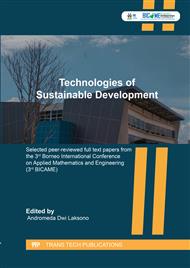[1]
Q. Wu, T. C. Qiang, G. Zeng, H. Zhang, Y. Huang, and Y. Wang, Sustainable and renewable energy from biomass wastes in palm oil industry: A case study in Malaysia, Int. J. Hydrogen Energy 42 (2017) 23871–23877.
DOI: 10.1016/j.ijhydene.2017.03.147
Google Scholar
[2]
H. Stichnothe, F. Schuchardt, and S. Rahutomo, European renewable energy directive: Critical analysis of important default values and methods for calculating greenhouse gas (GHG) emissions of palm oil biodiesel, Int. J. Life Cycle Assess 19 (2014) 1294–1304.
DOI: 10.1007/s11367-014-0738-x
Google Scholar
[3]
M. F. Awalludin, O. Sulaiman, R. Hashim, and W. N. A. W. Nadhari, An overview of the oil palm industry in Malaysia and its waste utilization through thermochemical conversion, specifically via liquefaction, Renew. Sustain. Energy Rev. 50 (2015) 1469–1484.
DOI: 10.1016/j.rser.2015.05.085
Google Scholar
[4]
N. Permpool, S. Bonnet, and S. H. Gheewala, Greenhouse gas emissions from land use change due to oil palm expansion in Thailand for biodiesel production, J. Clean. Prod. 134 (2016) 532–538.
DOI: 10.1016/j.jclepro.2015.05.048
Google Scholar
[5]
T. M. I. Mahlia, M. Z. Abdulmuin, T. M. I. Alamsyah, and D. Mukhlishien, An alternative energy source from palm wastes industry for Malaysia and Indonesia, Energy Convers. Manag. 42 (2001) 2109–2118.
DOI: 10.1016/s0196-8904(00)00166-7
Google Scholar
[6]
S. Yusoff, Renewable energy from palm oil - Innovation on effective utilization of waste, J. Clean. Prod. 14 (2006) 87–93.
DOI: 10.1016/j.jclepro.2004.07.005
Google Scholar
[7]
M. A. Teixeira, Heat and power demands in babassu palm oil extraction industry in Brazil, Energy Convers. Manag. 46 (2005) 2068–(2074).
DOI: 10.1016/j.enconman.2004.10.014
Google Scholar
[8]
F. R. P. Arrieta, F. N. Teixeira, E. Yáñez, E. Lora, and E. Castillo, Cogeneration potential in the Columbian palm oil industry: Three case studies, Biomass and Bioenergy 31 (2007) 503–511.
DOI: 10.1016/j.biombioe.2007.01.016
Google Scholar
[9]
A. Bazargan, S. L. Rough, and G. McKay, Compaction of palm kernel shell biochars for application as solid fuel, Biomass and Bioenergy 70 (2014) 489–497.
DOI: 10.1016/j.biombioe.2014.08.015
Google Scholar
[10]
D. A. Sudaryanti, Analisis ekonomi pemanfaatan palm oil mill effluent (pome) menjadi biopower. (2017). http://repository.ipb.ac.id/handle/123456789/91508.
Google Scholar
[11]
P. Anggraeni, Analisis ekonomi pemanfaatan fiber dan cangkang kelapa sawit menjadi energi listrik, Institut Pertanian Bogor, (2014).
Google Scholar
[12]
M. Mallaki and R. Fatehi, Design of a biomass power plant for burning date palm waste to cogenerate electricity and distilled water, Renew. Energy 63 (2014) 286–291.
DOI: 10.1016/j.renene.2013.09.036
Google Scholar
[13]
L. Conrad and I. Prasetyaning, Promotion of Least Cost Renewables in Indonesia Overview of the Waste-to-Energy Potential for Grid-connected Electricity Generation (Solid Biomass and Biogas) in Indonesia, no. March, (2014).
Google Scholar
[14]
P. Quaak, K. Harrie, and S. HUbert, WTP422 Energy from Biomass, World Bank Tech. Pap. 422 (1999) 1–78.
Google Scholar
[15]
M. Sulaiman, Studi Kelayakan Retrofit dan Potensi Keberlanjutan Pembangkit Listrik Tenaga Mikrohidro Tipe Turbin Ulir ICMI ALIF SAFITRI, Muhammad Sulaiman, S.T.,M.T.,D.Eng.;Dr.Rachmawan Budiarto, S.T.,M.T., (2018).
DOI: 10.24967/teksis.v6i2.1409
Google Scholar
[16]
M. Eichelbrönner, Panduan Pembiayaan Bioenergi untuk Pengembang Proyek Promotion of Least Cost Renewables in Indonesia ( LCORE-INDO ), (2017).
Google Scholar
[17]
Ministry of Energy and Mineral Resources Republic of Indonesia, The Minister Decree of Energy and Mineral Resources Republic of Indonesia No. 1772 K/20/MEM/2018: PT PLN (Persero) Cost of Power Generation in 2017, (2018).
Google Scholar
[18]
T. Kuvarakul, A. Pratidina, D. Anggraeni, and H. Saraswati, Renewable Energy Guideline on Biomass and Biogas Power Project Development in Indonesia, (2015).
Google Scholar
[19]
R. Rauch, Promotion of Least Cost Renewables in Indonesia (LCORE-INDO), Dtsch. Gesellschaft für Int. Zusammenarbeit, (2012).
Google Scholar
[20]
F. Sgroi, E. Donia, and D. R. Alesi, Renewable energies, business models and local growth, Land use policy 72 (2018) 110–115.
DOI: 10.1016/j.landusepol.2017.12.028
Google Scholar
[21]
L. Conrads, Promotion of Least Cost Renewables in Indonesia Grid-connected Biomass & Biogas Power Investment in Indonesia : Barriers and Policy Options Compiled by : Grid-connected Biomass & Biogas Power Investment in Indonesia : Barriers and Policy Options, (2014).
Google Scholar


